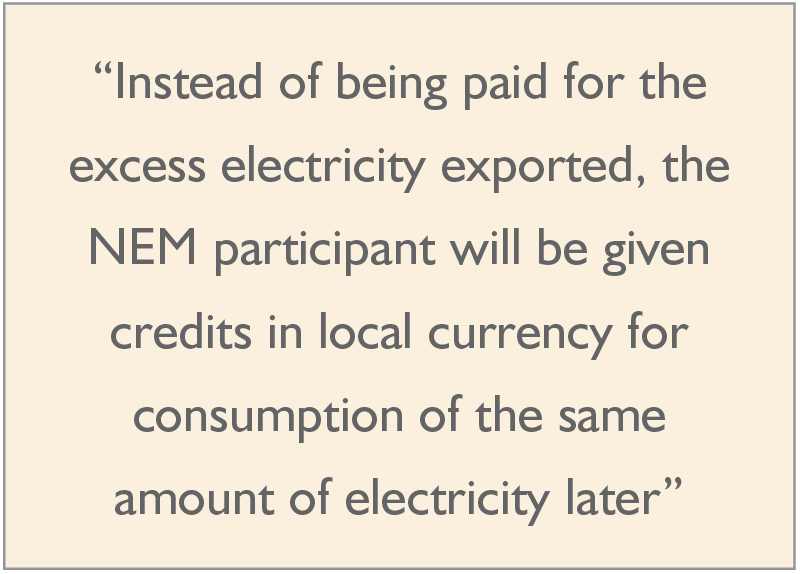 By Sharizan Bin Sarif, AZMI & Associates
By Sharizan Bin Sarif, AZMI & Associates
The government of Malaysia has introduced various incentives and strategies to encourage the growth of the renewable energy (RE) segment in Malaysia. Particularly in respect of solar energy, several measures such as the feed-in tariff (FiT) mechanism and large-scale solar (LSS) projects have been introduced to assist in achieving the nation’s RE target. In 2018, Malaysia will be in its third year of the implementation of its Net Energy Metering (NEM) scheme, as an additional incentive by the government for the promotion of RE.
Net Energy Metering scheme
The NEM scheme replaces the FiT mechanism, a special tariff system that obliges distribution licencees such as power utility companies (for example, Tenaga Nasional) to buy from the RE producers the electricity produced from RE resources (ie solar photovoltaic (PV), biogas, biomass, small-hydro and geothermal), for a price prescribed by Malaysia’s Sustainable Energy Development Authority (SEDA).
The NEM scheme, on the other hand, is a billing mechanism that provides solar PV system owners with credits in consideration for the excess electricity they generate and export to the national grid. In this regard, a solar PV system owner will first consume the electricity produced from the solar PV system for its own consumption (eg home, office, business, etc) instead of importing and buying electricity from a utility company. Any excess electricity generated from the solar PV system that is unused can then be exported and sold to the utility company at a rate known as the displaced cost, to be prescribed by the Energy Commission of Malaysia (EC).
Instead of being paid for the excess electricity exported, the NEM participant will be given credits in local currency (Malaysian ringgit) for consumption of the same amount of electricity later, to be set-off against future electricity bills. These monetary credits could be carried forward from one billing period to another, for a maximum period of 24 months, subject to the NEM participant having a legal contract for the supply of electricity by a utility company. Any available credits after the 24 months will be forfeited.
Unlike the FiT mechanism, the concept of NEM is that priority is for self-consumption. In this regard, participants are not actually trying to sell electricity to the utility companies but instead are trying to avoid buying electricity from the utility companies and importing from the national grid when their electricity consumption is high.

As the investment cost of installing a solar PV system to power up an upper-middle-income household may be between M$60,000 – M$100,000, the NEM scheme may be more attractive to high electricity consumption consumers, especially industry or manufacturing companies. Residential electricity consumers with very low consumption may find that the investment cost to participate under the NEM scheme may not be worthwhile.
The NEM would also benefit those who are looking to be free from any increases in the tariffs set by the utility companies. Currently, tariffs in Malaysia are relatively low, however, any increase in tariffs can be expected to affect consumers.
NEM scheme guidelines
The government, through the EC, has in 2016 issued guidelines for the purpose of implementing the NEM scheme, in line with the EC’s function to promote RE. The following are a few key clarifications as provided under the guidelines:
Source of energy
Unlike the FiT mechanism, the NEM is strictly for RE generated from solar PV resources. However, other RE resources may be allowed on a case-by-case basis.
Target capacity
The NEM programme is of 500MW capacity for a period between November 1, 2016 until 2020 with 100MW capacity limit a year for peninsular Malaysia, and another 100MW for the state of Sabah and the Federal Territory of Labuan.
Eligibility to participate
The Malaysia NEM programme is available to all residential, commercial (including government buildings) and industrial sectors.
Types of installation
The NEM mechanism will generally only allow excess energy from rooftops of buildings, garages and car parks to be exported to the national grid. However, any ground mounted systems may also be allowed by the EC, on a case-by-case basis.
Conclusion
The government of Malaysia continues to look at other incentives to further improve the take-up rate of RE, with the NEM scheme being a good mechanism to encourage participation of the public to generate their own electricity for self-consumption and reducing imports from the national grid. The issuance of the guidelines by the EC would provide electricity consumers with better understanding of the NEM scheme so that they may benefit by participating under the scheme and setting off their own consumptions to generate cost savings.

T: 603 2118 5000 Ext 5019


